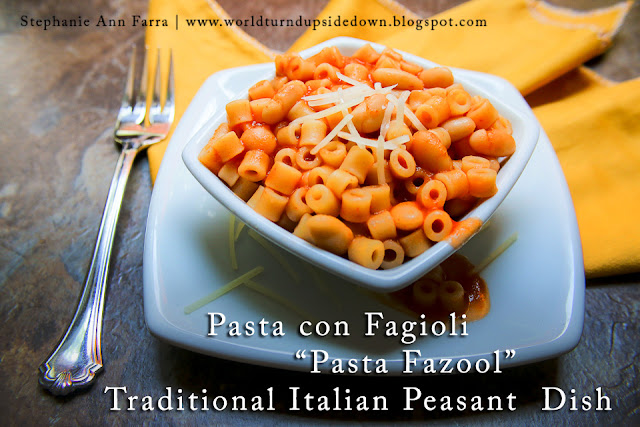This recipe was cooked for the Historical Food Fortnightly. A yearly challenge that encourages bloggers to cook a historical food every two weeks. The challenge this time was Ethnic Dishes and I chose to recreate the "Pasta Fazool" of my childhood. This dish was like a warm hug in your belly on chilly nights. My grandmother claimed my mother and her brothers didn't like it as kids but she made it on Fridays because it was cheap, easy and did not have meat in it.
Pasta con Fagioli (Pasta with Beans) has been popular since at least, the 1870s. There are many different recipes for it, some on the soupy side and some on the thicker side. The only real requirement is that the recipe contains both pasta and beans. The term "Pasta Fazool", which is what we always called it in my house, is a relaxed pronunciation of the Neapolitan and Sicilian pronunciation of beans.
Pasta con Fagioli (Pasta with Beans) has been popular since at least, the 1870s. There are many different recipes for it, some on the soupy side and some on the thicker side. The only real requirement is that the recipe contains both pasta and beans. The term "Pasta Fazool", which is what we always called it in my house, is a relaxed pronunciation of the Neapolitan and Sicilian pronunciation of beans.
I was torn on this recipe. I wanted to make it the way my grandmother used to when I was a kid. She told me she made it the way that her mother-in-law did but that she had the recipe in a book her mother gave her called The Italian Cookbook (1955.) This book is something special, I've never actually seen it before but it's the kind of cookbook I like to see: brimming with character and frequent use. Some people like their cookbooks squeaky clean with tight spines, but not me. The more newspaper clippings, tears, stains, written annotations, the better.
However the two recipes didn't match up the way I had hoped. The recipe in the cookbook specified soaking dry beans and making sauce and as much as I wanted to do it that way, it stated in the recipe, I did want to make the equally as authentic Pasta Fazool my grandma made with the time saving elements.
I stuck with the recipe I had to weasel out of my grandma. (You know how hard it is to get recipes from people who cook, right?) But I will add the ingredients list from the book at the bottom in case anyone wants to try.
The Challenge: Ethnic Foods (September 9 - September 22) Foodways and cuisine are at the heart of every ethnic group around the world and throughout time. Choose one ethnic group, research their traditional dishes or food, and prepare one as it is traditionally made.
The Recipe:
The Date/Year and Region: 1920s-1950s
Ingredients:
-1 Box Ditalini Pasta
- Olive Oil (enough to coat the bottom of the pan)
- 3 1/2 cups/28 ounces of Tomato Sauce of choice*
- 1 15.5 ounce can of Navy Beans or Northern Beans
- 1 Small Onion
- Salt and Pepper to taste
- Grated Parmesan
* Alternatively you can make your own sauce with crushed tomatoes, olive oil, oregano, pepper.
- Salt and Pepper to taste
- Grated Parmesan
* Alternatively you can make your own sauce with crushed tomatoes, olive oil, oregano, pepper.
How Did You Make It:
Coat the bottom of a medium size sauce pan, cooking on medium heat. Peel and add the whole onion, cover your pan. Stir the onion around occasionally until the outside of the onion starts to brown. Add the tomato sauce and the beans. Let cook about 10 minutes, stirring occasionally. Cook and drain the ditalini and return to pot. Stir in the sauce and beans. Remove the onion. Add salt and pepper to taste. If too thick, add water. Top with grated Parmesan.
Time to Complete: About 20 minutes.
Total Cost: $7.00
How Successful Was It?: Surprised myself. It didn't look like it should have until everything was combined. Tasted delicious.
How Accurate Is It?: Pretty close to grandma's. I did not eat the onion after I removed it although my grandma said that it was the best part.
Ingredients from The Italian Cookbook
-3 Cups Water
-1 1/4 Cups Navy Beans
-1/2 Teaspoon Salt
-2 Quarts Water
-1 Teaspoon Salt
-2 Cups Ditalini Pasta
-1/4 Cup Sieved Tomatoes
- 1 Tablespoon Olive Oil
- 1/4 teaspoon Pepper
- 1/4 teaspoon Oregano
- Grated Parmesan Cheese









